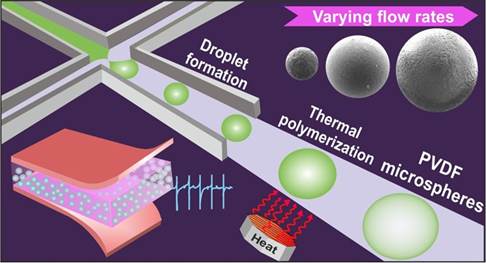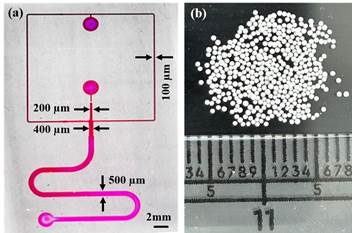Revolutionary Microfluidics Technology Powers Self-Powered Wearable Sensors
Researchers have developed a novel droplet microfluidics technology that produces polymer microspheres with a high electroactive (EA) phase, paving the way for advanced piezoelectric devices in wearable applications. These devices can function as self-powered sensors, capable of monitoring various physiological signals.
Polymer microspheres are renowned for their increased surface area and enhanced interface capabilities. However, conventional production methods often result in shape irregularities and high energy demands. Microfluidic techniques have emerged as a solution, offering benefits such as tunability, size and shape control, and efficiency. Although microspheres of Polyvinylidene fluoride (PVDF) have been produced using microfluidics, achieving a high EA phase remains challenging.
A team of researchers from the Institute of Nano Science and Technology (INST) in Mohali, an autonomous institute under the Department of Science and Technology, has addressed this challenge. They have introduced droplet microfluidics technology combined with an off-chip thermal polymerisation technique to synthesise tunable PVDF microspheres with a high EA phase. The resulting microspheres exhibited uniformity, monodispersity, and a narrow size distribution.
The high EA phase of these microspheres was achieved by adjusting the flow rates of oil and polymer solution in the microfluidic device. Extensive characterisation verified the piezoelectric response of the microspheres. The team successfully controlled the size of the microspheres (126-754 µm) and enhanced the EA phase to around 82% by optimising flow rates and reaction temperature.
Artificial intelligence (AI) played a crucial role in this research, enabling accurate predictions for microsphere diameter and phases. This approach reduced the need for extensive laboratory optimisation prior to droplet generation in microfluidics. The findings were recently published in the Chemical Engineering Journal.
As a proof of concept, the researchers demonstrated the application of PVDF microspheres in developing a flexible piezoelectric device. This device can seamlessly integrate with different parts of the human body, such as the elbow or knee, through wearables. It generates electrical responses by harnessing the energy produced by body movements, which would otherwise go to waste. The generated output voltage, around 23V, is substantial enough to operate low-power devices, highlighting the potential of this technology in creating efficient, self-powered sensors for wearable applications.

Figure: Schematic of overall work executed and its application

Figure: Schematic of the processing scheme of PVDF microparticles in a microfluidic device using off-chip thermal polymerization technique.

Figure: Digital images illustrating (a) a microreactor infused with dye to enhance visibility of microchannels and (b) PVDF microparticles.


